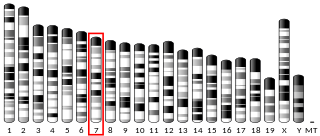
Cyclin-dependent kinase 4 also known as cell division protein kinase 4 is an enzyme that in humans is encoded by the CDK4 gene. CDK4 is a member of the cyclin-dependent kinase family.

Serine/threonine-protein kinase PAK 1 is an enzyme that in humans is encoded by the PAK1 gene.

DNA-dependent protein kinase, catalytic subunit, also known as DNA-PKcs, is an enzyme that in humans is encoded by the gene designated as PRKDC or XRCC7. DNA-PKcs belongs to the phosphatidylinositol 3-kinase-related kinase protein family. The DNA-Pkcs protein is a serine/threonine protein kinase comprising a single polypeptide chain of 4,128 amino acids.

Calcium/calmodulin-dependent protein kinase type II beta chain is an enzyme that in humans is encoded by the CAMK2B gene.

Calcium/calmodulin-dependent protein kinase type IV is an enzyme that in humans is encoded by the CAMK4 gene.

Serine/threonine-protein kinase PAK 4 is an enzyme that in humans is encoded by the PAK4 gene.

Dachshund homolog 1, also known as DACH1, is a protein which in humans is encoded by the DACH1 gene. DACH1 has been shown to interact with Ubc9, Smad4, and NCoR.

Serine/threonine-protein kinase PAK 5 is an enzyme that in humans is encoded by the PAK5 gene.

Ras Related Glycolysis Inhibitor and Calcium Channel Regulator (RRAD) is a protein that in humans is encoded by the RRAD gene. RRAD is a Ras-related small GTPase that is regulated by p53 and plays a role in the regulation of aerobic glycolysis.

Protein phosphatase 1 regulatory subunit 14A also known as CPI-17 is a protein that in humans is encoded by the PPP1R14A gene.

Calcium/calmodulin-dependent protein kinase kinase 2 is an enzyme that in humans is encoded by the CAMKK2 gene.

Serine/threonine-protein kinase PAK 6 is an enzyme that in humans is encoded by the PAK6 gene.

Serine/threonine-protein kinase LMTK2 also known as Lemur tyrosine kinase 2 (LMTK2) is an enzyme that in humans is encoded by the LMTK2 gene.

MicroRNA 489 is a miRNA that in humans is encoded by the MIR489 gene.

Cytoskeleton regulator RNA is a long non-coding RNA that in humans is encoded by the CYTOR gene.

CKLF-like MARVEL transmembrane domain-containing protein 3, also termed chemokine-like factor superfamily 3, is a member of the CKLF-like MARVEL transmembrane domain-containing family of proteins. In humans, CMTM2 protein is encoded by the CMTM3 gene located in band 22.1 on the long arm of chromosome 16. This protein is expressed in a wide range of tissues, including fetal tissues. It is highly expressed in the male reproductive system, particularly testicular tissues and may play a role in the development of this tissue. It is also highly expressed in the immune system including circulating blood cells, i.e. B lymphocytes, CD4+ T lymphocytes, and monocytes. However, CMTM3 protein is weakly expressed or unexpressed in the malignant tissues of several types of cancers. In many but not all of theses cancers, this decreased or lack of expression appears due to methylation of the GpC islands in the promoter region, and thereby the silencing, of the CMTM3 gene.

MicroRNA 495 is a protein that in humans is encoded by the MIR495 gene.

Calcium/calmodulin dependent protein kinase IG is a protein that in humans is encoded by the CAMK1G gene.
Small nucleolar RNA host gene 1 is a non-protein coding RNA that in humans is encoded by the SNHG1 gene.
CKLF-like MARVEL transmembrane domain-containing 5 (CMTM5), previously termed chemokine-like factor superfamily 5, designates any one of the six protein isoforms encoded by six different alternative splices of its gene, CMTM5; CMTM5-v1 is the most studied of these isoforms. The CMTM5 gene is located in band 11.2 on the long arm of chromosome 14.




















